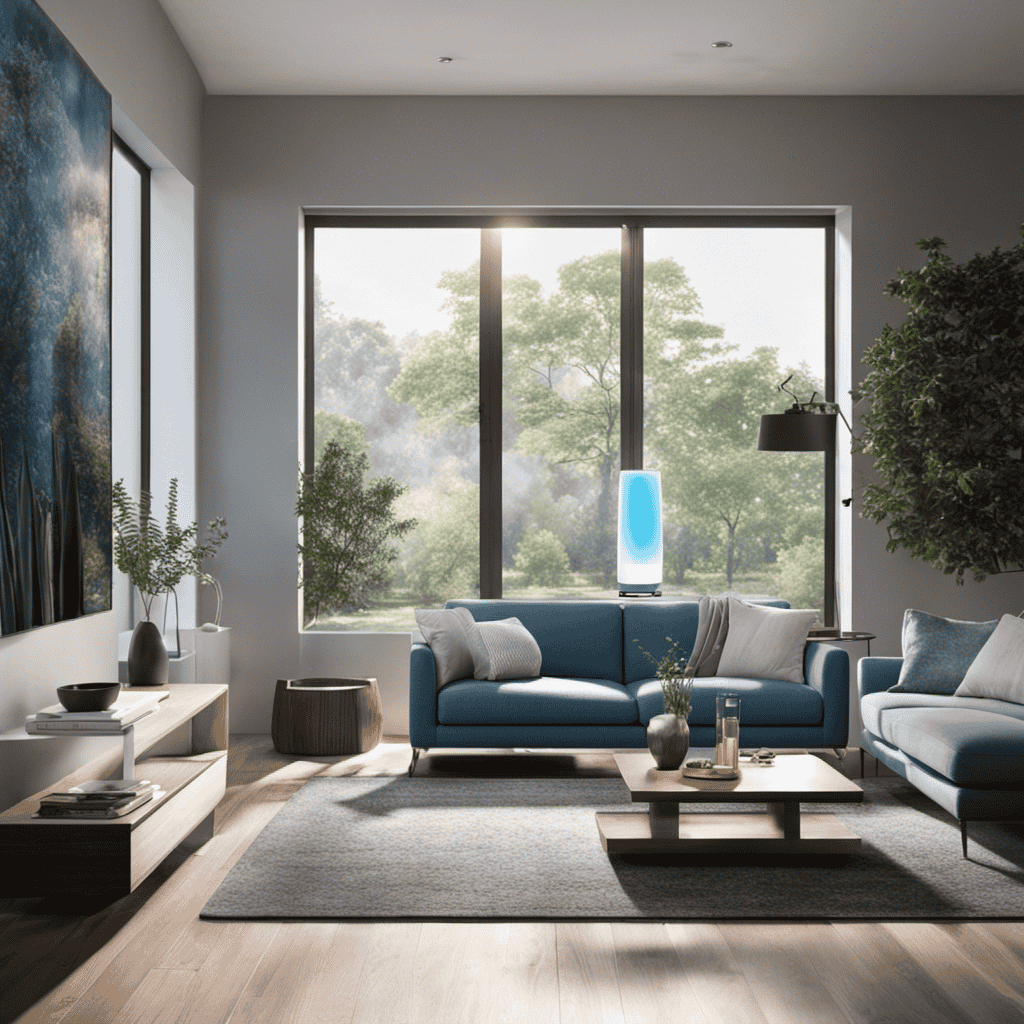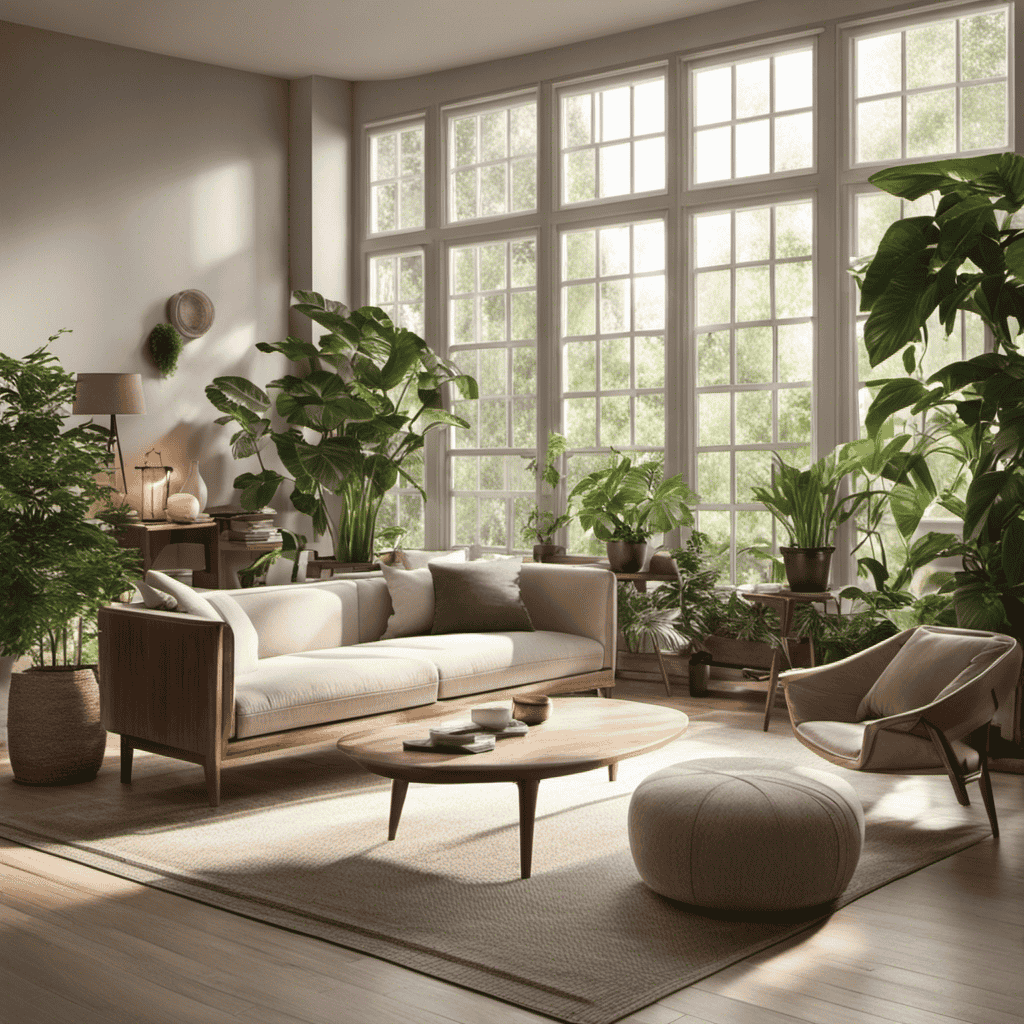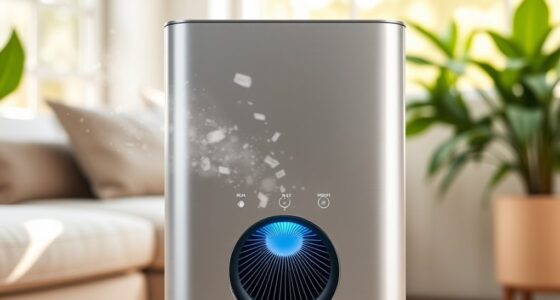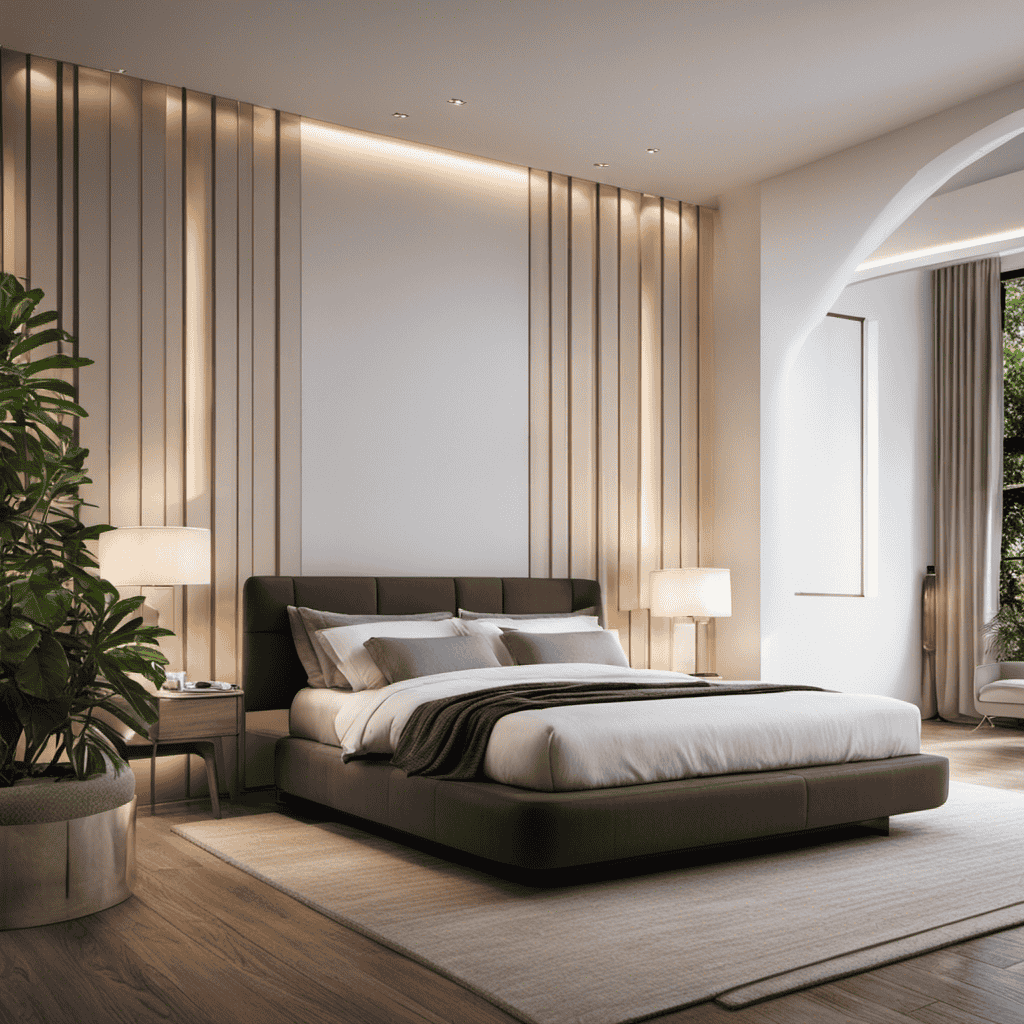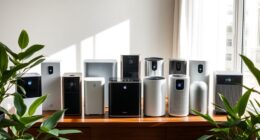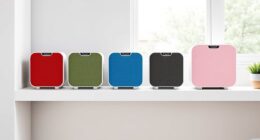As a specialist in air quality and purification, I have observed that many individuals are uncertain about the frequency at which they should run their air purifiers.
Well, here’s an interesting statistic: did you know that the Environmental Protection Agency (EPA) estimates that indoor air can be two to five times more polluted than outdoor air?
With that in mind, it becomes crucial to understand the optimal usage of air purifiers to maintain a healthy living environment.
In this article, I will guide you through the factors to consider and recommended operating hours for air purifiers, so you can make informed decisions and breathe cleaner air.
Key Takeaways
- The size of the space and air quality in the area are important factors to consider when determining the usage of an air purifier.
- Understanding and assessing indoor air quality is crucial in determining how often an air purifier should be on, including monitoring factors such as humidity levels, ventilation, and pollutants.
- Proper ventilation and regular maintenance of HVAC systems are important for optimal air quality and reducing the need for constant air purifier usage.
- The specific needs and requirements of individuals, such as allergies, odor elimination, and VOC reduction, should be taken into account when determining how often an air purifier should be on.
Factors to Consider When Determining Air Purifier Usage
When determining how often to use your air purifier, you should consider factors such as the size of your space and the air quality in your area. These factors play a crucial role in determining the recommended operating hours for air purifiers.
The size of your space is important because it determines the amount of air that needs to be filtered. Smaller spaces may require less frequent usage, while larger spaces may require the air purifier to be on for longer periods of time.
Additionally, the air quality in your area is another important factor to consider. If you live in an area with poor air quality, such as a city with high levels of pollution, it is recommended to keep your air purifier on for longer periods of time to continuously filter the air and maintain a healthier environment. On the other hand, if you live in an area with relatively clean air, you may only need to use your air purifier for a few hours a day to maintain good air quality.
Considering these factors will help you determine the optimal usage of your air purifier to maximize its health benefits and ensure a clean and fresh environment.
With this understanding, let’s explore the recommended operating hours for air purifiers.
Recommended Operating Hours for Air Purifiers
To ensure optimal performance, it’s best to run your air purifier for a set number of hours each day. The recommended operating hours for air purifiers can vary based on several factors affecting air purifier usage.
Here are some key benefits of using air purifiers and factors to consider when determining the ideal operating hours:
-
Improved Indoor Air Quality: Air purifiers help remove allergens, pollutants, and other harmful particles from the air, improving the overall air quality in your home or office.
-
Allergy Relief: By capturing and removing allergens such as pollen, dust mites, and pet dander, air purifiers can provide relief for individuals suffering from allergies or asthma.
-
Odor Elimination: Air purifiers with activated carbon filters can effectively eliminate odors from cooking, pets, or smoke, leaving your space smelling fresh and clean.
-
Respiratory Health: Breathing clean air reduces the risk of respiratory issues, such as coughing, wheezing, and shortness of breath, promoting better overall respiratory health.
-
Better Sleep: Air purifiers can create a more conducive environment for sleep by reducing airborne irritants and providing clean, fresh air for a restful night’s sleep.
Considering these factors, it is recommended to run your air purifier for at least 8-10 hours per day to maintain clean air consistently. However, the actual operating hours may vary depending on the size of the room, the level of pollution, and individual needs.
It’s important to refer to the manufacturer’s guidelines and adjust the operating hours accordingly for optimal performance and maximum benefits.
Understanding the Air Quality in Your Home
Understanding the air quality in your home can be achieved by monitoring various factors such as humidity levels, ventilation, and the presence of pollutants. Air quality monitoring is essential to ensure a healthy living environment for you and your family.
Indoor pollutant sources can include chemicals from cleaning products, tobacco smoke, pet dander, and even volatile organic compounds (VOCs) emitted by furniture and building materials. These pollutants can have adverse effects on your health, leading to respiratory issues, allergies, and other health problems.
To effectively monitor air quality, it is important to use appropriate tools and techniques. One commonly used tool is an air quality monitor, which measures parameters such as temperature, humidity, particulate matter, and VOC levels. This device provides real-time data, allowing you to identify any potential issues and take appropriate actions to improve air quality.
In addition to monitoring, it is crucial to address indoor pollutant sources. Taking preventive measures like proper ventilation, using natural cleaning products, and minimizing the use of chemicals can help reduce the presence of pollutants in your home. Regularly cleaning and maintaining your HVAC system, as well as regularly replacing air filters, can also contribute to better air quality.
How to Assess the Level of Indoor Air Pollution
Air pollution is a significant issue that affects not only the environment but also our health. Understanding the sources of air pollution is crucial in order to address this problem effectively.
Additionally, it is important to be aware of the health effects associated with air pollution, as they can have serious implications on our well-being.
Air Pollution Sources
You should be aware of the various sources of air pollution. Air pollution can come from both natural and human-made sources. Here are five sources of air pollution that can have a significant impact on human health:
-
Vehicle emissions: The exhaust from cars, trucks, and motorcycles releases pollutants like nitrogen oxides and particulate matter.
-
Industrial emissions: Factories and power plants release pollutants such as sulfur dioxide and carbon monoxide into the air.
-
Household activities: Burning fuels for cooking and heating, as well as using certain cleaning products and paints, can release pollutants indoors.
-
Agricultural practices: The use of fertilizers and pesticides in farming can lead to the release of pollutants like ammonia and volatile organic compounds.
-
Waste management: Improper disposal of waste, such as burning trash, can release harmful pollutants into the air.
Understanding these sources of air pollution is crucial for implementing effective air pollution prevention measures and minimizing the impact on human health.
Health Effects of Pollution?
When it comes to the health effects of pollution, it’s important to be aware of the potential risks and take necessary precautions. Exposure to pollutants can have a detrimental impact on our health, leading to various respiratory and cardiovascular conditions.
The sources of pollution are vast and varied, including industrial emissions, vehicle exhaust, and indoor pollutants like tobacco smoke and volatile organic compounds. These pollutants can infiltrate our homes and workplaces, compromising the quality of the air we breathe.
To mitigate the health risks associated with pollution, it is crucial to consider the importance of proper ventilation in conjunction with air purifier usage. Adequate ventilation helps remove indoor pollutants, while air purifiers further enhance air quality by filtering out harmful particles and contaminants.
The Importance of Proper Ventilation in Conjunction With Air Purifier Usage
To ensure optimal air quality, it’s crucial to use an air purifier in conjunction with proper ventilation. Proper ventilation benefits both the air purifier’s effectiveness and our overall health. Here are five compelling reasons why:
-
Reduces indoor air pollutants: Proper ventilation helps remove pollutants such as allergens, dust, and chemicals from indoor spaces, allowing the air purifier to work more effectively in capturing and filtering them.
-
Prevents condensation and mold growth: Adequate ventilation helps control humidity levels, preventing condensation and mold growth. Mold spores can be harmful to our health, and the air purifier can help remove them from the air.
-
Enhances air circulation: Proper ventilation ensures proper air circulation throughout the room, preventing stagnant air pockets where pollutants can accumulate. The air purifier can then capture these pollutants and improve the overall air quality.
-
Reduces odors: Ventilation helps remove unpleasant odors from indoor spaces, while the air purifier can further eliminate any lingering smells, leaving the air fresh and clean.
-
Promotes better respiratory health: With proper ventilation, the air we breathe becomes cleaner and healthier. This, combined with the air purifier’s ability to filter out pollutants, can significantly improve respiratory health and reduce the risk of respiratory issues.
Allergies and Air Purifiers: Finding the Right Balance
Finding the right balance between allergies and air purifiers can greatly improve our respiratory health. Allergies can be a constant source of discomfort, with symptoms like sneezing, watery eyes, and congestion. Air purifiers, on the other hand, can help remove allergens from the air, providing relief and improving indoor air quality. However, it is important to use air purifiers effectively to maximize their benefits.
To achieve the best results, there are a few best practices for effective relief. First, it is important to choose the right type of air purifier for your specific allergies. Different purifiers are designed to target different allergens, such as dust mites, pet dander, or pollen. Refer to the table below for a breakdown of common allergens and the corresponding air purifier type that can effectively remove them:
| Allergen | Recommended Air Purifier Type |
|---|---|
| Dust Mites | HEPA Filter |
| Pet Dander | HEPA Filter or Activated Carbon Filter |
| Pollen | HEPA Filter or Electrostatic Filter |
| Mold Spores | HEPA Filter or UV-C Light |
In addition to choosing the right purifier, it is important to properly maintain and regularly clean your air purifier. This includes changing the filters as recommended by the manufacturer and keeping the unit free from dust and debris. By finding the right balance between allergies and air purifiers and following these best practices, we can effectively reduce allergens in our indoor environment and experience improved respiratory health.
How Often Should an Air Purifier Run in Different Environments
In my previous discussion, we explored the importance of finding the right balance between allergies and air purifiers. Now, let’s delve into the question of how often an air purifier should run in different environments.
It is crucial to consider the recommended filter types, noise levels, and the specific needs of each environment.
Here are five key factors to consider when determining how often an air purifier should be running:
- The size of the room: Larger rooms may require longer running times to effectively clean the air.
- The level of pollution: High pollution levels, such as in urban areas or near industrial sites, may necessitate longer running times for optimal air purification.
- The presence of allergens: Individuals with allergies may benefit from having the air purifier running continuously to minimize the allergen exposure.
- Pets or smokers in the vicinity: If there are pets or smokers in the area, running the air purifier more frequently can help remove pet dander and smoke particles from the air.
- Sensitivity to noise: Some individuals may find the noise generated by air purifiers to be bothersome, and may choose to run them only when they are not in close proximity.
Considering these factors, it is important to strike a balance between running the air purifier enough to achieve clean air and avoiding excessive noise or energy consumption.
Now, let’s explore the role of air purifiers in reducing odors and volatile organic compounds (VOCs).
The Role of Air Purifiers in Reducing Odors and Volatile Organic Compounds (VOCs
When it comes to the effectiveness of air purifiers in eliminating odors, it is important to consider the specific type of odor and the capabilities of the purifier.
Some purifiers are designed specifically for odor elimination and are equipped with activated carbon filters that can effectively remove odorous particles from the air.
Additionally, the reduction of volatile organic compounds (VOCs) is another important aspect to consider when evaluating the efficiency of an air purifier. VOCs are harmful chemicals that can be released from various sources like paint, cleaning products, and furniture, and a high-quality air purifier with a strong VOC reduction efficiency can help improve indoor air quality.
Lastly, to ensure optimal usage of an air purifier, it is recommended to run it continuously or for a significant portion of the day to maintain clean and fresh air throughout the space.
Odor Elimination Effectiveness
The air purifier’s odor elimination effectiveness can be improved by using activated carbon filters. These filters are highly effective at trapping and removing odors from the air, making them an essential component of any air purifier designed for odor removal. Here are five reasons why activated carbon filters are the best choice for odor elimination:
-
Highly porous: Activated carbon filters have a large surface area with countless tiny pores, allowing them to adsorb a wide range of odorous compounds.
-
Chemical adsorption: The activated carbon in these filters chemically binds with odor molecules, effectively neutralizing them and preventing them from being released back into the air.
-
Versatility: Activated carbon filters can remove a variety of odors, including those from pets, cooking, smoke, and chemicals.
-
Long-lasting: These filters have a longer lifespan compared to other types of filters, ensuring continuous odor elimination for an extended period.
-
Safe and eco-friendly: Activated carbon filters are non-toxic and environmentally friendly, making them a safe choice for both humans and the planet.
When it comes to odor elimination techniques, using air purifiers with activated carbon filters is the best option for achieving a clean and fresh-smelling indoor environment.
Vocs Reduction Efficiency
To improve the VOCs reduction efficiency, you can consider using an air purifier with activated carbon filters. These filters are specifically designed to trap and remove volatile organic compounds (VOCs) from the air, effectively reducing their concentration in your indoor environment.
Activated carbon is highly porous and has a large surface area, allowing it to adsorb VOC molecules and prevent them from re-entering the air. Numerous studies have shown the effectiveness of activated carbon filters in reducing VOCs, making them a reliable choice for improving indoor air quality.
By incorporating this technology into your air purifier, you can significantly enhance its ability to remove harmful chemicals and pollutants from your surroundings. This is especially important for individuals with respiratory conditions or those living in areas with high levels of VOCs.
Transitioning into the subsequent section about ‘optimal purifier usage’, understanding the recommended usage and maintenance of your air purifier will ensure its continued effectiveness.
Optimal Purifier Usage
For best results, make sure you regularly clean and replace the filters in your air purifier. This is crucial to maintain the efficiency of your purifier and ensure it continues to provide clean and healthy air.
Here are five benefits of using an air purifier and how it can improve indoor air quality:
-
Removes allergens: An air purifier can capture and remove common allergens such as pollen, pet dander, and dust mites, reducing allergic reactions and improving respiratory health.
-
Eliminates odors: Air purifiers equipped with activated carbon filters can effectively remove unpleasant odors, leaving your home smelling fresh and clean.
-
Reduces airborne germs: Some air purifiers are equipped with HEPA filters that can trap bacteria, viruses, and other airborne pathogens, minimizing the risk of respiratory infections.
-
Controls asthma triggers: By removing triggers like dust, mold spores, and pet dander, air purifiers can help manage asthma symptoms and improve overall lung function.
-
Enhances sleep quality: Cleaner air can lead to better sleep by reducing nasal congestion and improving overall respiratory function, allowing for a more restful night’s sleep.
With these benefits, investing in an air purifier can greatly improve the quality of the air you breathe indoors.
Air Purifier Usage for Homes With Pets
Pets can cause increased allergens in the air, so it’s important to consider their presence when deciding how often to use an air purifier. Air purifiers provide numerous benefits, including the control of pet dander, which is a common allergen. Pet dander consists of tiny particles of skin and hair that pets shed. These particles can easily become airborne and trigger allergic reactions in sensitive individuals. An air purifier equipped with a high-efficiency particulate air (HEPA) filter is highly effective in capturing and removing pet dander from the air. By continuously running the air purifier, you can significantly reduce the concentration of pet dander in your home, making it a more comfortable environment for both you and your pet.
However, the frequency of air purifier usage may vary depending on the number of pets you have and their shedding patterns. If you have multiple pets or pets that shed heavily, running the air purifier continuously or for longer periods of time may be necessary to maintain a clean and allergen-free indoor air quality. On the other hand, if you have fewer pets or pets that shed minimally, running the air purifier for shorter periods or on a timed schedule may be sufficient.
Transitioning into the subsequent section about seasonal considerations for air purifier usage, it’s important to note that different seasons can bring different challenges in terms of pet dander control and overall air quality.
Seasonal Considerations for Air Purifier Usage
As we delve into the seasonal considerations for air purifier usage, there are several key points to explore.
Firstly, understanding allergen levels and usage is crucial in determining how frequently and effectively we should use air purifiers.
Secondly, the impact of weather on purifiers cannot be ignored, as different seasons bring varying levels of pollutants and particles into the air.
Lastly, adjusting our purifier settings and strategies to accommodate changing seasons is essential in maintaining optimal indoor air quality throughout the year.
Allergen Levels and Usage
You should consider reducing the usage of your air purifier when the allergen levels are low. While air purifiers are effective in removing allergens from the air, they consume energy and contribute to your electricity bill. Here are five reasons to consider reducing air purifier usage when allergen levels are low:
- Save energy and reduce electricity costs
- Extend the lifespan of your air purifier
- Decrease the environmental impact
- Allow natural ventilation for fresh air
- Avoid over-reliance on technology for allergen control
To determine when allergen levels are low, you can use air quality testing devices or consult local pollen forecasts. By being mindful of allergen levels, you can optimize your air purifier usage, saving energy and improving overall air quality.
Weather Impact on Purifiers
When it’s humid outside, it’s important to monitor the impact of weather on your purifiers. Humidity can affect the effectiveness of air purifiers, especially if they rely on filters. High humidity can lead to moisture buildup in the filters, reducing their ability to capture and remove pollutants from the air.
Additionally, extreme temperatures, such as heatwaves or cold snaps, can also impact purifier effectiveness. Temperature fluctuations can cause the filters to expand or contract, potentially compromising their ability to filter out contaminants.
It is crucial to consider the outdoor air quality as well when using purifiers. If the outdoor air quality is poor, with high levels of pollutants such as pollen or smoke, it may be necessary to run the purifier for longer periods to maintain clean indoor air.
Overall, monitoring and adjusting purifier usage based on weather conditions and outdoor air quality is essential to ensure optimal effectiveness.
Adjusting for Changing Seasons
To maintain optimal performance, it’s important to adjust your purifier settings as the seasons change. The changing seasons bring different air quality challenges, and it’s crucial to adapt your purifier accordingly.
Here are some key considerations for adjusting your purifier settings:
-
Increase or decrease fan speed: During peak allergy seasons, such as spring and fall, you may need to increase the fan speed to effectively capture pollen and other allergens. In the winter, when outdoor air pollution is typically lower, you can decrease the fan speed to conserve energy.
-
Adjust timer settings: As the seasons change, so does the amount of time you spend indoors. Adjusting the timer settings on your purifier can help ensure that it runs when you need it most and conserves energy when you don’t.
-
Monitor air quality sensor readings: Many purifiers come with built-in air quality sensors that automatically adjust the purification settings based on real-time readings. Pay attention to these readings and adjust your purifier settings accordingly.
-
Regularly replace filters: Different seasons bring different air pollutants. It’s essential to regularly replace your purifier’s filters to maintain optimum performance. Check the manufacturer’s recommendations for filter replacement frequency.
-
Consider using different filters: Some purifiers offer interchangeable filters designed for specific pollutants. Adjusting your filter type based on the season can help you target the specific contaminants that are more prevalent during that time.
Air Purifiers and Asthma: Best Practices for Effective Relief
If you have asthma, it’s important to know the best practices for effective relief when using air purifiers. As someone who has struggled with asthma for many years, I have found that using the right air purifier can greatly improve my symptoms and overall quality of life.
When it comes to choosing the best air purifiers for managing asthma symptoms, there are a few key factors to consider. First and foremost, you want to look for a purifier that has a HEPA (High Efficiency Particulate Air) filter. This type of filter is designed to capture small particles like pollen, pet dander, and dust mites, which are common triggers for asthma attacks.
In addition to a HEPA filter, it’s also important to consider the size and coverage area of the purifier. You want to make sure that the purifier is powerful enough to effectively clean the air in the room or rooms where you spend the most time.
To help you in your search for the best air purifier for asthma relief, here is a comparison table of three top-rated models:
| Air Purifier | HEPA Filter | Coverage Area |
|---|---|---|
| Model A | Yes | 300 sq. ft. |
| Model B | Yes | 500 sq. ft. |
| Model C | Yes | 700 sq. ft. |
Determining the Size and Capacity of an Air Purifier for Optimal Performance
To ensure optimal performance, consider factors like room size and coverage area when determining the size and capacity of your air purifier. It is crucial to choose the right air purifier for your space to effectively clean the air and improve indoor air quality.
Here are several important factors to consider when sizing your air purifier:
-
Room Size: The square footage of the room plays a significant role in determining the size of the air purifier you need. Larger rooms require air purifiers with higher capacity to effectively clean the air.
-
Air Changes per Hour (ACH): ACH refers to the number of times an air purifier can clean the entire volume of air in a room within an hour. Higher ACH values are desirable for better air purification.
-
Clean Air Delivery Rate (CADR): CADR measures how efficiently an air purifier can remove smoke, dust, and pollen particles from the air. Look for an air purifier with a CADR rating that matches your room size.
-
Filter Types: Different air purifiers use different types of filters, such as HEPA, activated carbon, or UV filters. Consider the specific pollutants you want to target and choose an air purifier with the appropriate filter type.
-
Noise Level: Some air purifiers can be quite noisy, especially at higher fan speeds. If noise is a concern for you, opt for a quieter model to ensure a peaceful environment.
Maintenance Tips to Ensure Longevity and Efficiency of Air Purifiers
Make sure you regularly clean and replace the filters in your air purifier to maintain its longevity and efficiency. Proper maintenance is crucial for ensuring that your air purifier continues to function effectively and provide you with clean and healthy air. Here are some maintenance tips to help you keep your air purifier in top condition.
Firstly, it is essential to clean or replace the filters according to the manufacturer’s guidelines. Filters trap airborne particles and pollutants, but over time, they can become clogged and less effective. Cleaning or replacing them regularly will ensure that your air purifier can continue to remove pollutants from the air efficiently.
Additionally, it is important to clean the exterior of your air purifier regularly. Dust and dirt can accumulate on the surface, which can hinder its performance. Use a soft cloth or a vacuum cleaner with a brush attachment to remove any dirt or debris from the exterior of the unit.
Furthermore, don’t forget to check and clean the air intake vents. These vents allow air to flow into the purifier for filtration. If they become blocked or clogged with dust, the air purifier’s efficiency can be compromised. Use a brush or a vacuum cleaner to remove any dirt or debris from the vents.
Is It Safe to Leave an Air Purifier Running When I’m Not Home?
Yes, leaving an air purifier unattended is generally safe. Modern air purifiers are designed with safety features, such as automatic shut-off switches and timers, to prevent overheating and fire hazards. However, it’s always a good idea to follow the manufacturer’s guidelines and periodically check the device for any malfunctions.
Frequently Asked Questions
Can an Air Purifier Remove All Types of Indoor Air Pollutants?
An air purifier can effectively remove various types of indoor air pollutants, including dust, pet dander, pollen, mold spores, and even certain volatile organic compounds (VOCs).
By utilizing filters and technologies like HEPA filters, activated carbon filters, and UV-C light, air purifiers can capture and neutralize these pollutants, improving indoor air quality.
The benefits of using an air purifier include reducing allergy symptoms, eliminating odors, and creating a healthier living environment.
How Do I Know if My Air Purifier Is Working Effectively?
To determine if my air purifier is working effectively, I look for signs of a faulty unit, like weak airflow or strange odors.
I also monitor the air quality in my home using a separate air quality monitor.
To improve the efficiency of my air purifier, I make sure to clean or replace the filters regularly and keep the unit away from obstructions.
Additionally, I ensure proper ventilation in my home to maximize the purifier’s effectiveness.
Is It Safe to Run an Air Purifier Overnight?
It is safe to run an air purifier overnight, as long as it is used correctly and maintained properly.
Running an air purifier during the night can help improve indoor air quality and reduce potential health risks associated with pollutants and allergens.
To optimize the effectiveness of an air purifier during nighttime use, make sure to close all windows and doors, clean or replace filters regularly, and adjust the fan speed to a lower setting for quieter operation.
Can I Use an Air Purifier in Multiple Rooms at the Same Time?
Using an air purifier in multiple rooms simultaneously can be beneficial. It helps in purifying the air from pet dander and other allergens, making it safer for those with allergies or asthma.
Additionally, using an air purifier in the office can improve air quality, reducing the risk of respiratory issues and increasing productivity.
However, it’s important to consider the size and capacity of the air purifier to ensure effective purification in each room.
How Often Should I Replace the Filters in My Air Purifier?
When it comes to cleaning my air purifier, I make sure to replace the filters regularly. The frequency of filter replacement depends on various factors such as the manufacturer’s recommendation, the air quality in my home, and the specific type of air purifier I have.
To choose the right air purifier filters, I consider the size of particles they can capture, the filter’s efficiency, and the type of pollutants I want to eliminate.
Regularly cleaning and replacing the filters ensures optimal performance of my air purifier.
Conclusion
In conclusion, determining the appropriate usage of an air purifier depends on various factors such as the air quality in your home, level of indoor air pollution, and the need for proper ventilation.
It is recommended to run the air purifier for a minimum of 8 hours a day for optimal performance.
Interestingly, studies have shown that indoor air can be up to five times more polluted than outdoor air, making it crucial to use an air purifier to improve the air quality in our homes.
By following maintenance tips and selecting the right size and capacity, we can ensure longevity and efficiency of our air purifiers.
